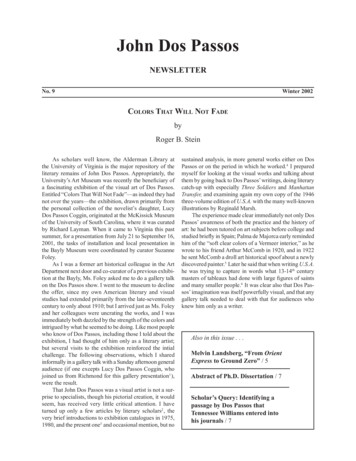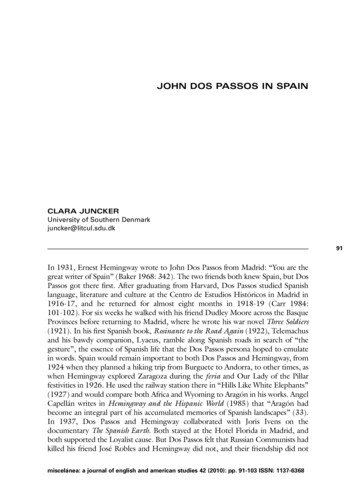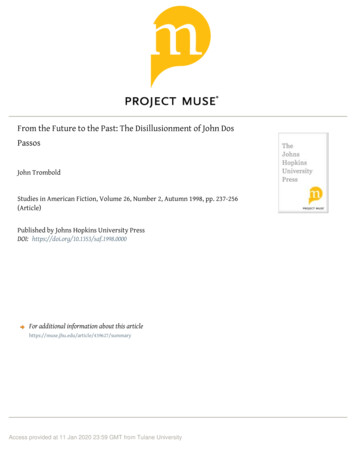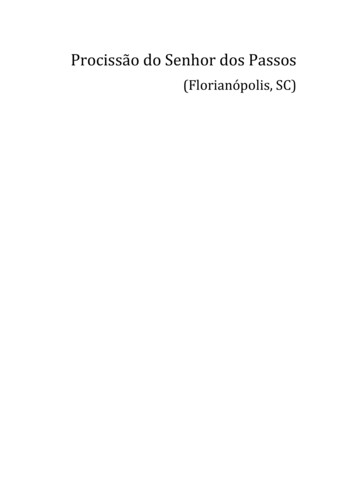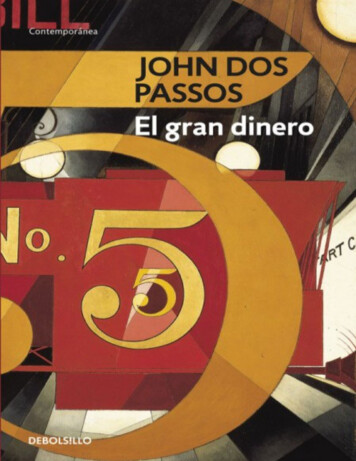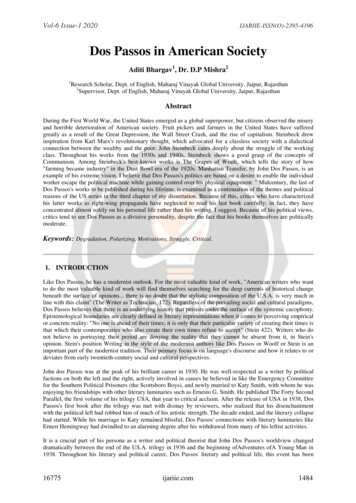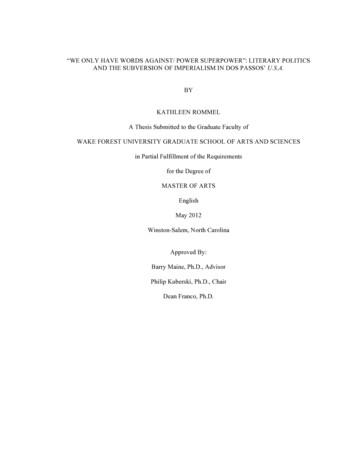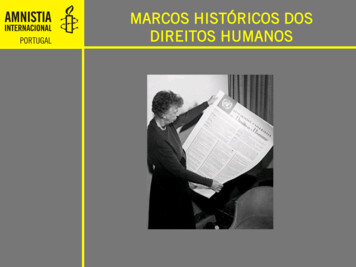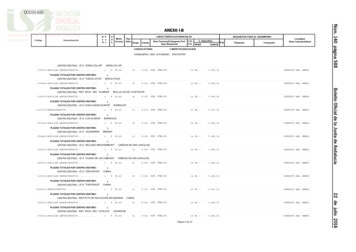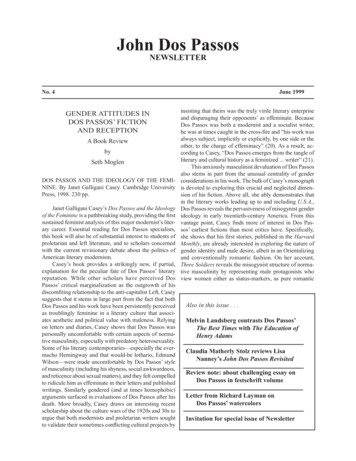
Transcription
John Dos Passos NewsletterJune 19991John Dos PassosNEWSLETTERNo. 4June 1999GENDER ATTITUDES INDOS PASSOS’ FICTIONAND RECEPTIONA Book ReviewbySeth MoglenDOS PASSOS AND THE IDEOLOGY OF THE FEMININE. By Janet Galligani Casey. Cambridge UniversityPress, 1998. 230 pp.Janet Galligani Casey’s Dos Passos and the Ideologyof the Feminine is a pathbreaking study, providing the firstsustained feminist analysis of this major modernist’s literary career. Essential reading for Dos Passos specialists,this book will also be of substantial interest to students ofproletarian and left literature, and to scholars concernedwith the current revisionary debate about the politics ofAmerican literary modernism.Casey’s book provides a strikingly new, if partial,explanation for the peculiar fate of Dos Passos’ literaryreputation. While other scholars have perceived DosPassos’ critical marginalization as the outgrowth of hisdiscomfiting relationship to the anti-capitalist Left, Caseysuggests that it stems in large part from the fact that bothDos Passos and his work have been persistently perceivedas troublingly feminine in a literary culture that associates aesthetic and political value with maleness. Relyingon letters and diaries, Casey shows that Dos Passos waspersonally uncomfortable with certain aspects of normative masculinity, especially with predatory heterosexuality.Some of his literary contemporaries—especially the evermacho Hemingway and that would-be lothario, EdmundWilson—were made uncomfortable by Dos Passos’ styleof masculinity (including his shyness, social awkwardness,and reticence about sexual matters), and they felt compelledto ridicule him as effeminate in their letters and publishedwritings. Similarly gendered (and at times homophobic)arguments surfaced in evaluations of Dos Passos after hisdeath. More broadly, Casey draws on interesting recentscholarship about the culture wars of the 1920s and 30s toargue that both modernists and proletarian writers soughtto validate their sometimes conflicting cultural projects byinsisting that theirs was the truly virile literary enterpriseand disparaging their opponents’ as effeminate. BecauseDos Passos was both a modernist and a socialist writer,he was at times caught in the cross-fire and “his work wasalways subject, implicitly or explicitly, by one side or theother, to the charge of effeminacy” (20). As a result, according to Casey, “Dos Passos emerges from the tangle ofliterary and cultural history as a feminized . writer” (21).This anxiously masculinist devaluation of Dos Passosalso stems in part from the unusual centrality of genderconsiderations in his work. The bulk of Casey’s monographis devoted to exploring this crucial and neglected dimension of his fiction. Above all, she ably demonstrates thatin the literary works leading up to and including U.S.A.,Dos Passos reveals the pervasiveness of misogynist genderideology in early twentieth-century America. From thisvantage point, Casey finds more of interest in Dos Passos’ earliest fictions than most critics have. Specifically,she shows that his first stories, published in the HarvardMonthly, are already interested in exploring the nature ofgender identity and male desire, albeit in an Orientalizingand conventionally romantic fashion. On her account,Three Soldiers reveals the misogynist structure of normative masculinity by representing male protagonists whoview women either as status-markers, as pure romanticAlso in this issue . . .Melvin Landsberg contrasts Dos Passos’The Best Times with The Education ofHenry AdamsClaudia Matherly Stolz reviews LisaNanney’s John Dos Passos RevisitedReview note: about challenging essay onDos Passos in festschrift volumeLetter from Richard Layman onDos Passos’ watercolorsInvitation for special issue of Newsletter
John Dos Passos Newsletter2idealizations, or as the objects of a sexuality that is indistinguishable from violence.Casey’s critical analysis is most revelatory in her discussion of Streets of Night and Manhattan Transfer. Drawing heavily on the feminist film theorist Laura Mulvey, sheargues that the main female characters in both novels aretrapped in a “specular economy” in which they must eitherembrace the role of passive but willing object of the sexualmale “gaze,” or else lose the possibility of any form ofsexual connection or social visibility. Either way, womenare deprived of sexual subjectivity and social agency bythis ideological double-bind. While in Streets of Night,Nan refuses to be the “object of the gaze” and is doomedalong with both of her male suitors to sexual repressionand frustration, Ellen Thatcher in Manhattan Transfer isthe first of a series of Dos Passos’ female protagonists tomanipulate this ideologically constructed male desire forher own financial gain, as a sexualized media icon. DosPassos forces us to recognize the disastrous position inwhich women have been placed by showing that the poweracquired by even a consummate manipulator of the systemlike Ellen is nevertheless “a supreme illusion” because theideological game she is playing has deprived her of any“sense of self, of true subjectivity” (118, 121). Casey is ather best when explaining the subtlety of Dos Passos’ fusionof gender and class analyses in his fictional anatomization of “gendered capitalism” (114) in this novel: whileEllen’s class position enables her to elude the economicexploitation suffered by the working-class Anna Cohen,for example, her financial privilege blinds her to the waysin which she shares the fate of female objectification, assexual fetish rather than worker.Casey’s analysis of U.S.A. also contains valuableinsights. Viewing the male-dominated biographies as theTHE JOHN DOS PASSOS NEWSLETTERThe Newsletter seeks to promote scholarship onand interest in Dos Passos’ writings and biography,and will publish short articles on these subjects. Itwill also publish news items, notes, letters, and queries on these and other relevant matters. Among thesematters are work in progress, manuscript locationsand accessions, bibliographies, and textual scholarship.For return of manuscripts, contributors shouldsend, along with their submissions, stamped envelopes addressed to themselves. They should addressall queries and manuscripts to the editor, MelvinLandsberg, Department of English, University ofKansas, Lawrence, KS 66045-2115. Our fax numberis (785) 864-4298.COPYRIGHT 1999 by Melvin LandsbergAll rights reserved.June 1999most regressive strand of the trilogy from a gender perspective, she argues that the Camera Eye and Newsreelsegments provide a “coherent locus of ‘feminist’ insight”(135). The Newsreels, in particular, focus increasing attention on women’s growing economic and social powerduring and after World War One and on the violence againstwomen that accompanied it. The fictional storylines ofU.S.A. collectively demonstrate that “sexual destinies”and gender roles are “predetermined” by ideology: themale characters all assume cultural superiority to womenand are represented as “sexual victimizers,” while femalecharacters must “learn to cope with their status as victims.”Extending one of the trilogy’s most emblematic assertions,Casey suggests that for Dos Passos “America is not onlydivisible into two economic nations. but also two gendered ones” (158).Unfortunately, Casey’s argument about U.S.A. is moretendentious, more contradictory and less convincing thanher discussion of earlier works. She asserts that U.S.A.evolves in a feminist direction, as the predominant sexismof The 42nd Parallel and especially Nineteen Nineteengives way to the dramatically more feminist outlook of TheBig Money. Casey weakens her own argument by overstating her case. She claims, for example, that the feministcontent of The Big Money is principally revealed by thefact that the most central male character in this volume,Charley Anderson, “represents the most complete susceptibility to the nation’s dominant ideological paradigms,”while the primary female characters, Margo Dowling andMary French, embody “a valorized cultural resistance”(174). I suspect that few readers will be convinced thatMargo, who is thoroughly implicated in the destructivenew culture industry which Dos Passos deplored, shouldbe viewed as a heroine in the author’s eyes. And whileMary French is indeed the most sympathetic of U.S.A.’sfictional characters, Casey’s claim that Mary is the “singleefficacious radical figure” in the trilogy and offers “a newparadigm for social activism” seems unfounded (174).Mary, after all, like all the fictional radicals, participatesin a long series of failed activist campaigns, culminating inthe futile effort to save the lives of Sacco and Vanzetti—thelost cause of the radical Left which touched Dos Passosmost personally.The interpretive strains and overstatements containedin Casey’s analysis of U.S.A. stem from a deeper conceptualproblem. She has adopted an unnecessarily rigid and deterministic model of ideology which causes her to compromise many of her most sophisticated textual interpretationsand her most significant historical arguments. Althoughshe alludes to a large number of theorists, her conceptionof ideology derives principally from a particular strandof post-structuralist thought—exemplified most clearlyby Laura Mulvey—which has attempted to adapt Althusserian and Lacanian models for feminist ends. In practice,Casey tends to view ideological determination as virtuallycomplete and absolute. What she appears to admire mostin Dos Passos is the way in which his novels suggest a
June 1999John Dos Passos Newslettersimilar determinism: she commends U.S.A., for example,for demonstrating that “ideological imprisonment” is “inescapable” (175). Because Dos Passos represents misogynistgender ideology as central to the shaping of individualconsciousness and American culture as a whole, Caseyviews him as offering a feminist critique. But Casey’sown progressive political ambitions as a feminist cause herto strain (for good reason) against her own deterministicideological model. As a feminist, Casey is concerned tolocate spaces of female and feminist agency in a misogynistculture—and she wishes to identify locations of resistanceto ideological determination. Because her theoretical modelmakes it difficult to understand how determination andagency can coexist, however, she tends to vacillate betweenexaggerating the ideological determinism of Dos Passos’texts and exaggerating the agency that he represents: hencethe overstatement of Mary’s effectiveness as an activist.Casey also seems to presume that ideological formations are relatively pure, consistent, and politically univalent. In the chapters on Dos Passos’ early fiction and onManhattan Transfer, for example, she seems determinedto avoid acknowledging that Dos Passos was capable ofbeing both a misogynist and a feminist. As a result, sherepeatedly quotes explicitly misogynist passages fromhis fiction and then tries to explain away the misogyny bysuggesting unconvincingly that these passages might beconstrued as ironic. Casey’s tendency to view ideological formations as rigid has also reduced the subtlety ofthe historical arguments which her research should haveenabled. She notes in several places, for example, that attitudes among American anti-capitalists toward women andfeminism were “mixed.” But she repeatedly underminesthis historical recognition by reifying the Left as simplymisogynist. Similarly, while she endorses Cary Nelson’scall to revise conceptions of modernism in order to honorits complex relationship to Left politics, Casey’s openingdiscussion ends up reinforcing the vision that modernistsand proletarian writers constituted distinct, warring camps.As a result of these theoretical rigidities, Casey hasunfortunately obscured the most significant implicationsof her own project. Her excellent research and her oftensubtle textual analysis actually reveal that Dos Passoswas a socialist modernist whose fictions are at once conventionally misogynist and daringly feminist. To see DosPassos in this complex way ought to enable us to see theexistence of a powerful anti-capitalist strand within modernism, and it should encourage us to understand that thegender politics of both modernism and the American Leftwere more conflicted than has usually been acknowledged.Casey fails to argue for these insights because she assumesthat the rich contradictions and complexities that she findsin Dos Passos were not also present in the larger socialistand modernist ideological formations of which he was apart. Presuming that ideologies are rigid and totalizing, thatthey impose themselves on writers but are not continuallyaltered by them, Casey ends up presenting Dos Passos asan anomaly, rather than as emblematic of modernism and3the Left. It is worth emphasizing the reductive effects ofthis model of ideology-critique because it has, in variousforms, become commonplace in U.S. versions of culturalstudies.I do not, however, want to underestimate the significance of what Casey has achieved. Dos Passos and theIdeology of the Feminine is an enormous contribution toDos Passos scholarship. With the waning of Cold War taboos, there is growing interest today in Dos Passos—and anew generation of teachers and students will be especiallyinterested in the remarkable gender politics of his work.While Casey’s book is not the last word on this subject,she has inaugurated the discussion, and scholars will beindebted to her for this groundbreaking study.Seth Moglen is Assistant Professor of English atLehigh University. He is working on a book entitled “AnOther Modernism: John Dos Passos and the Politics ofLiterary Form.”
John Dos Passos Newsletter4THE BEST TIMESANDTHE EDUCATION OF HENRY ADAMSA CONTRASTbyMelvin LandsbergThe world is an entertaining though horribly tryingplace, and it is best enjoyed when one is young. It is onlyin reference to his youth that Dos Passos uses the title TheBest Times for the memoir he published in 1966. Howotherwise could the name apply to his experiences withWorld War I and the Sacco-Vanzetti affair? Friendship andtravel are the major joys he describes in his 233-page book,which takes us from his birth to the years when U.S.A.was appearing. Sharing vicariously in his friendships andtravels gives the book much of its savour.I read recently that a Random House poll of literarycritics has found The Education of Henry Adams the bestwork of non-fiction originally published in English in thetwentieth century. Nobody asked my opinion, but if someone had I would have made a much more modest claimfor The Best Times: An Informal Memoir (to use the fullname). It is a neglected work, more sunny, more charitable,immensely more spirited, and at least as intelligent andinteresting. Note that I do not claim that it, or any otherbook, is one of a select hundred.Let us look first at each subject’s achievements, amajor source of our interest in any autobiography. And letus look too at what each wanted. Adams was an impressivehistorian, a journalist, the editor of the North AmericanReview, and a Harvard professor. But a huge item in hisaccount of his career was a strong grievance: the postCivil War milieu did not allow him—a public-spirited andcapable (as he saw himself) scion of the three generationsof statesmen—to become president, or at least a leader inthe nation.Dos Passos was primarily a novelist, at his peak agreat one, though never in The Best Times does he applya yardstick to himself. He comes closest to the subject inthe following passage, about his views in the early 1920s:Literary invention could never bemade really reputable. A writer who tookhis trade seriously would be sure to getmore kicks than ha’pence. He wouldbe lucky if he stayed out of jail. In myrevulsion against wartime stupidities,as a priest takes a vow of celibacy, Ihad taken a private vow of allegiance toan imaginary humanist republic whichto me represented the struggle for lifeagainst the backdrag of death and stagnation. Figures like Giordano Bruno,June 1999Erasmus, Rabelais, Montaigne presidedover my republic of letters. Among itslatterday saints I classed Shelley, Stendahl, Flaubert, possibly Walt Whitmanand Rimbaud.This isn’t the sort of thing one talksabout, even to intimate friends, but itis these private dedications that moldmen’s lives. In this context the numberof copies a book sold was neither herenor there. The celebrity racket made nosense at all (134).1Like Adams fifty-eight years before, Dos Passos attended Harvard College, but compared to Adams he was agamin. Adams in his first sentence relates that he was bornon Beacon Hill in Boston in 1838 and christened later byhis uncle, the minister of the First Unitarian Church. Beinga great grandson of John Adams and a grandson of JohnQuincy Adams, he was at the pinnacle of social distinctionfrom the start.Dos Passos’ memoir does not even say where he wasborn—in Chicago, far from his father’s and mother’s separate homes, as he was the unacknowledged love child of amarried man. The novelist’s paternal grandfather fell lightyears short of John Quincy Adams’ distinction; he was, DosPassos tells us, a short-tempered man who left Madeira ina rush because of “some incident involving a stabbing”(4). He worked as a cobbler and later as a shoemaker inBaltimore, then moved to Philadelphia, where he marriedand had children. Though the family was poor and hadlittle food, Dos Passos’ grandfather would throw dinner outthe window if his wife hadn’t prepared it just right. DosPassos’ father, a forceful person, became an outstandinglawyer despite his impoverished childhood.Dos Passos was not baptized, a fact that discomfitedproper people when he was a boy, and he did not bear hisfather’s name at Choate, the preparatory school he attended. Indeed, there is more than a whiff of the picaresquein his memoir.Adams says he “made no acquaintance in collegewhich proved to have the smallest use in after life” (64).“ . . . never would he have need of acquaintance tostrengthen his social standing; but he needed greatly someone to show him how to use the acquaintance he cared tomake” (64).2Dos Passos, unlike Adams, was hungry for friends whohad personal qualities to which he could relate.3 He mademany at college, particularly on the Harvard Monthly, andenlivens his memoir with accounts of numbers of them:E. E. Cummings; Dudley Poore, another poet; StewartMitchell, later a historian; Robert Hillyer, a third poet;Arthur McComb, who became an art historian, and twowho died early, Edward Massey, a playwright, and WrightMcCormick, a journalist.Of the friends he made in Spain after college, he describes José (Pepe) Giner, a devout young man who knew
June 1999John Dos Passos Newsletter“every sacristan and every forgotten masterpiece in thevillages tucked away in the rolling lands of Castile” (30).Together the two walked through these lands and climbedin the Sierra Guadarrama. Another young Spaniard withwhom he made trips, and who became a lifelong friend,was Pepe Robles, a cynical, sharp-tongued student who“laughed at everything,” and was an “aficionado of bullfights” (32, 33).The secret behind his friendships was that he wasreceptive to a wide variety of human beings. In the yearsafter World War I, for example, he, E. E. Cummings, andsome of their friends found the Jewish East Side “particularly romantic.”Saturday nights we would foregather at Moskowitz’s “RumanianBroilings” on a street east of SecondAvenue.Mr. Moskowitz was a courtlywaspwaisted little man who played thezymbalom while we drank his wine. . .Sometimes we talked about theRussian Revolution with Yiddish journalists and poets. These were wellinformed and skeptical people. . . .Mr. Moskowitz played well. He likedto feel he was an artist among artists.Sometimes he would be so moved bythe enthusiasm of our response that hewould distribute free wine (84).Contrast this comment with Henry Adams’, when hewrites of coming into New York from Europe in 1868:His world was dead. Not a PolishJew fresh from Warsaw or Cracow—nota furtive Yacoob or Ysaac still reekingof the Ghetto, snarling a weird Yiddishto the officers of the customs—but hada keener instinct, an intenser energy,and a freer hand than he—Americanof Americans, with Heaven knew howmany Puritans and Patriots behind him,and an education that had cost a civilwar (238).In the Education we see the American Civil War fromEngland with Adams. He served as private secretary tohis father, the U.S. Minister to Great Britain, who soughtto keep that country from aiding the Confederacy witharmaments and recognizing it as an independent nation.The climax of the account of diplomatic maneuveringscomes when Minister Adams, trying in 1863 to stop thepreparation and unleashing of two ironclad rams built forthe Confederacy, informs Lord Russell, the British foreignminister: “It would be superfluous in me to point out to5your lordship that this is war!” (172) Following his mainthread, treating all his experiences as failures in his education, Adams tells how he misconstrued the intentions ofLord Palmerston, the prime minister, and of Russell. Amidhis accounts of his father’s policies, he tells about how hehimself fared in the London social season.For Dos Passos, the most memorable war in his memoir is also the one he knew in his twenties: Word War Iin Europe. And he writes as a direct participant, often afront-line ambulance driver there. A pacifist and a socialistbelieving in revolution, he went to Europe because thatwas where the greatest and most momentous drama inthe world was occurring. Once by the French front—andbeing twenty-one—he wrote of “building myself a snailshell of hysterical laughter against the hideousness of war”and “having a wonderful time” (51).Education for Dos Passos came at every turn. Earlyin his activity on the road supplying Verdun, he and hisfriends Hillyer and Frederik van den Arend found a countryvilla that a shell had completely demolished; they weredelighted, however, to find that it had a beautiful backhousewhich was entirely intact. The three kept the place, withits scrubbed deal seats, their secret.We had found the latrines the mosthideous feature of the wartime scene,slippery planks over stinking pits. TheBoche seemed to have an evil intuitionabout them; as soon as you squatted withyour pants down, he would start to shell(42).Does Henry Adams, in the five-hundred pages of hisEducation, written in an elevated diction nowhere descending to the plebeian, ever use a privy?Before he left Europe, following his discharge fromthe Red Cross for writing pacifist letters, Dos Passos hada haunting experience. After an American offensive, probably Château Thierry, he answered a call for volunteers towork at a base hospital in Paris.The night I particularly rememberit was my job to carry off buckets fullof amputated arms and hands and legsfrom an operating room.Who could hold on to dogmaticopinions in the face of these patheticremnants of shattered humanity? (70)Still another part of his education came after he managed to get into the American army after his return tothe United States. Now he was with ordinary Americansoldiers, not college volunteers; a farm boy from Indianaand an Italian from one of the western states helped himconceive of Chrisfield and Fuselli, two of the main characters in Three Soldiers.
6John Dos Passos Newsletter“One friend in a lifetime is much; two are many; threeare hardly possible,” says Adams (312). For him in theEducation, it was two: Clarence King, the geologist, andJohn Hay, the author and diplomat, who was Secretary ofState under Presidents McKinley and Theodore Roosevelt.Writing of the deaths of these two, Adams says that it wastime for him to go:The three friends had begun lifetogether; and the last of the three hadno motive—no attraction—to carry iton after the others had gone. Educationhad ended for all three (505).For Dos Passos, the gates of admission to friendshipare wider, and the procession of friends, as he sees them,is long. To follow his memoir is to view this procession,and also his ability to bond with many kinds of people.In 1921 he and Cummings sailed from New Bedfordto Portugal on the freighter Mormugão. Before they left,Arthur McComb gave Dos Passos The Degradation ofthe Democratic Dogma, by Henry Adams and his brotherBrooks, to read on the ship. Dos Passos says that he hatedthe book “because it went against the Walt Whitmannarodnik optimism about people I’ve never quite liveddown” (87). From Paris he went on across the Balkans andTurkey, witnessing untold post-war horrors along the way.In New York, he had met Paxton Hibben, an American whohad been a U.S. diplomat, then a war correspondent, andnow was with the Near East Relief. The two were by thistime friends. Hibben was unable to get him work with theN.E.R., but instead got him a document allowing passage ina Soviet railway boxcar to the Persian border. In the boxcarhe formed a friendly relationship with a Persian physician,Sayid Hassan Tabataba, who was returning home from aGerman medical school, and together they travelled on toTeheran. After Dos Passos made his way, by car, wagon,and rail to Baghdad (as ever, noting terrain, customs, andmonuments on the way), a sympathetic British official arranged for him to journey in an Arab caravan to Damascus.Over five weeks of sometimes dangerous travel followed, under the protection of Jassem-er-Rawwaf, the tall,dark-bearded caravan leader. Once again in the memoir,Dos Passos displays his interest in and liking for people.Sitting at Jassem’s campfire, he listens to the leader tell ofhis country in southern Arabia, and tries to explain howmuch he likes the life the Agail people live in the desert.Jassam invites him to give up the “stinking cities” andcome live with them (117). However, when Dos Passos hasa shave in Damascus and puts on a western suit, Jassem,tears in his eyes, repudiates him.In the chapters following that which describes thecaravan, Dos Passos talks much more about his friends oracquaintances, those we have mentioned and others. Manyare celebrities, among them F. Scott Fitzgerald, EdmundWilson, Archibald MacLeish, Hart Crane, John HowardJune 1999Lawson, Mike Gold, Picasso, Léger, Blaise Cendrars.Others are less well known, e.g., Dawn Powell and JohnPeale Bishop; still others are far from being public figures.None of the celebrities seems imported to gain the booknotice; they were all very much part of his experiences.And however strong his liking, he can be memorable injudgment. Fond as he was of Cummings, he remarks of himin later life: “Tolerance is not a New England vice” (134).Of F. Scott Fitzgerald, whose talent he admired, he says:“The idea of being that kind of celebrity set my teeth onedge” (130). Fernand Léger and Pablo Picasso were friendsof Sara Murphy, another of his friends, and Léger becamea favorite of Dos Passos; but of Picasso, he says: “He wasskill incarnate . . . if he had had the gift of compassion hewould have been as great as Michelangelo” (153).Dos Passos in leading up to the cooling of Hemingway’s friendship, has a memorable passage, not quite apage long, but too long to quote here. The gist is: “As aman matures he sheds possibilities with every passing year.In the same way he sheds friendships” (218-219).Hemingway had turned on his friend after Dos Passosdenounced the activities of the Communists in the Spanish Civil War, and afterwards had wounded him with hiscomments. Dos Passos does not write of these later occurrences. But amid his more happy recollections of timeswith Hemingway, he has bits like: “Hem was the greatestfellow in the world to go around with when everythingwent right” (201). Quite deftly Dos Passos identifies theturning point in their relationship with an incident in KeyWest: Hemingway caught Dos Passos throwing his Panamahat at, and trying to ring, a plaster cast of a badly botchedbust of his difficult friend (220).By and large, though, Dos Passos’ tone is one of fondremembrance, as with his recollections of John HowardLawson, who had onesidedly ended their relationship whenDos Passos wouldn’t stop denouncing the Communists.Henry Adams’ extensive descriptions of his travels inEurope, in the chapters “Berlin (1858-1859)” and “Rome(1859-1860),” are rich in commentary and sometimesskillfully pithy. But as he subordinates the informationto his quest for education, one recalls them primarily aswell-wrought cerebration.To read Dos Passos on his trip through the Caucasus in1928 is, on the other hand, not merely to participate in thetrip, but to do so through the senses and mind of a novelistrenowned for his ability to create place, as in ManhattanTransfer and U.S.A. A few sentences stand out in my mind:From the moment we left Shattoi—these names are all spelled wrong,I never could find them on any map—wewere riding up one mountain pass afteranother. The guides would never taketheir horses farther than the next valleybecause it would be inhabited by a different people and they didn’t know the
June 1999John Dos Passos Newsletterlanguage. The Russians were helpless asI was. At every night’s stop we had tofind fresh interpreters. . . . The uplandswere sheep country. A shepherd we meton the road had never heard of America(184-185).On part of the trip he travelled with Horsley Gantt, aVirginia physician who had been studying with Pavlov foryears. The two Americans had met by chance in a Leningrad hotel, and they struck up a friendship that lasted untilDos Passos’ death.Near the start of Dos Passos’ memoir, there is a longer and more vivid portrait than any of his others, that ofhis father. From “The Camera Eye” in The Forty-SecondParallel, we know how difficult the relationship must havebeen. In The Best Times, Dos Passos writes of another sideof it: his father’s friendship and intellectual tutorship. Inintroducing his account of the elder Dos Passos, the sonmake
June 1999 John Dos Passos Newsletter 1 Also in this issue . . . Melvin Landsberg contrasts Dos Passos' The Best Times with The Education of Henry Adams Claudia Matherly Stolz reviews Lisa Nanney's John Dos Passos Revisited Review note: about challenging essay on Dos Passos in festschrift volume Letter from Richard Layman on Dos Passos .
